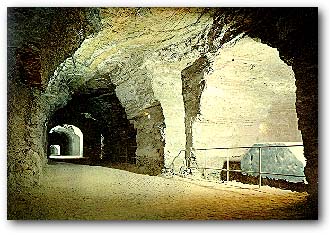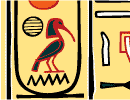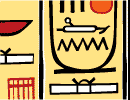| The Serapeum  Apis are buried. Archeologist Mariette
discovered this temple in 1850, in the early days of archeology. In this dig, he found the
famous "Squatting Scribe" statue. This statue is considered to be one of the greatest sculptures
ever found. He also found the statue of the dwarf god, Bes. In Le Serapeum de Memphis,
Mariette describes some of his excitement about his find: Apis are buried. Archeologist Mariette
discovered this temple in 1850, in the early days of archeology. In this dig, he found the
famous "Squatting Scribe" statue. This statue is considered to be one of the greatest sculptures
ever found. He also found the statue of the dwarf god, Bes. In Le Serapeum de Memphis,
Mariette describes some of his excitement about his find:
"One finds," said the geographer Strabo (1st century AD), "a temple to Serapis in such a
sandy place that the wind heaps up the sand dunes beneath which we saw sphinxes, some half
buried, some buried up to the head, from which one can suppose that the way to this temple
could not be without danger if one were caught in a sudden wind storm." Did it not seem that
Strabo had written this sentence to help us rediscover, after over eighteen centuries, the
famous temple dedicated to Serapis? It was impossible to doubt it. This buried Sphinx, the
companion of fifteen others I had encountered in Alexandria and Cairo, formed with them,
according to the evidence, part of the avenue that led to the Memphis Serapeum...
It did not seem to me possible to leave to others the credit and profit of exploring this temple
whose remains a fortunate chance had allowed me to discover and whose location henceforth
would be known. Undoubtedly many precious fragments, many statues, many unknown texts
were hidden beneath the sand upon which I stood. These considerations made all my scruples
disappear. At that instant I forgot my mission (obtaining Coptic texts from the monasteries), I
forgot the Patriarch, the convents, the Coptic and Syriac manuscripts, Linant Bey himself, and
it was thus, on 1 November 1850, during one of the most beautiful sunrises I had ever seen in
Egypt, that a group of thirty workmen, working under my orders near that sphinx, were about
to cause such total upheaval in the conditions of my stay in Egypt."
Worship of the Apis bull was a late development. The bull was thought to have been an
incarnation of Ptah. The sacred bulls were buried in a single block of granite that weighed
between sixty and eighty tons. All twenty-four sarcophagi had been plundered. Their lids had
been prised loose and the contents taken. Further excavation revealed an older gallery and
then another one further on. The way into the first of the galleries was blocked by a huge rock.
Explosives were used to open the way. Beneath where the rock had been, was found a
mummy of a man. This was the mummy of a son of Ramesses II, Prince Kha-m-was. He was
in charge of the restoration of the Pyramid of Unas. He was also governor of Memphis and a
high priest of Ptah. He had requested to be buried with the sacred bulls rather than a tomb of
his own.
|





